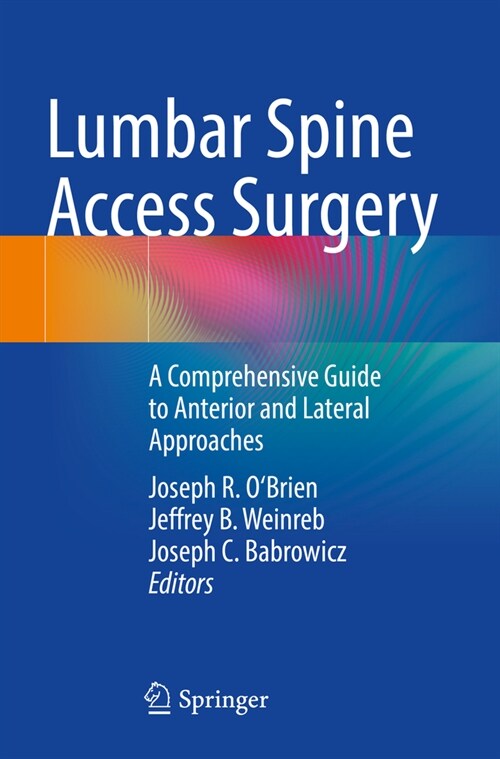<목차>
Part I History and Rationale of Lumbar Spine Access Surgery
1 Overview of Anterior Lumbar Spine Access Surgery 3
2 History and Evolution of Anterior Lumbar Spine Access Surgery 17
3 Rationale for Anterior Lumbar Spine Surgery 29
Part II Preoperative Care for Lumbar Spine Access Surgery
4 Patient Selection for Anterior Lumbar Access Surgery 35
5 Imaging Review for Anterior Lumbar Access Surgery 43
6 Informed Consent for Anterior Lumbar Access Surgery 49
Part III Intraoperative Care for Lumbar Spine Access Surgery
7 Patient Positioning and Marking for Anterior Lumbar Access Surgery 61
8 Adjunctive Measures: Neuromonitoring, Perfusion Monitoring, Foley 69
9 Incision Choice for Anterior Lumbar Access Surgery 83
10 ALIF Retractor Options for Anterior Lumbar Access Surgery 91
Part IV Operative Technique for Lumbar Spine Access Surgery
11 Mini-Open Anterior Retroperitoneal Approach 97
12 Anterior Transperitoneal Approach to the Lumbar Spine 117
13 Biomechanics of Anterior, Oblique, and Lateral Approaches to the Lumbosacral Spine 131
14 Direct Lateral Transpsoas Approach 145
15 Adjunctive Analgesia Methods 153
Part V Intraoperative Complications for Lumbar Spine Access Surgery
16 Arterial Complications 163
17 Venous Complications 169
18 Ureteral Injury 185
Part VI Postoperative Care for Lumbar Spine Access Surgery
19 Pain Management 193
20 Venous Thromboembolic Issues 209
21 Wound Complications 217
22 Fluid Collections 229
23 Ileus Prevention and Management 237
Part VII Additional Considerations for Lumbar Spine Access Surgery
24 Revision Anterior and Lateral Spinal Access Surgery 249
25 Anterior Lumbar Spine Access Surgery in Ambulatory Surgery Centers and Outpatient Settings 259
26 Preoperative Considerations for Anterior Lumbar Interbody Fusion Revision 271
27 Anterior and Lateral Interbody Techniques for Revision Lumbar Fusion 277
28 Understanding Spine Biologics for the Access Surgeon 291
29 Lumbar Access Surgery Performed by a Spine Surgeon 301
30 Prone Lateral Interbody Fusion 307
31 Minimally Invasive Thoracolumbar Approaches with Diaphragm Preservation 321
32 Minimally Invasive Trauma Corpectomy of the Lumbar Spine 329
33 Access to L1–L2 and L2–L3 341
34 Anterior Approaches to the Cervical Spine 359
Index 371
Quality surgeons must have all the tips, tricks, and tools to provide their patients with the best care
possible. Anterior and lateral approaches have revolutionized spine surgery, but even so, many surgeons
have not learned the procedures and treatment involved, and the ones who have demonstrate a very difficult
learning curve. This can be partially attributed to a lack of instructional literature, and this book aims
to fill this gap so that incoming as well as veteran surgeons can add the anterior and lateral approaches
to their arsenal.
This text guides the surgeon through the full arc of treatment: from deciding which approach to use to
treating the patient post-operatively. Specifically, the reader will gain comprehensive knowledge on how to
perform each access procedure, how to care for and treat the patient at every stage, and the best ways to
handle an array of complications they may face. Seven sections present everything the surgeon needs to
know: history and rationale; preoperative and intraoperative care, surgical techniques, intraoperative
complications, postoperative care, and a final section covering additional considerations for revision
surgery, biological treatments, and approaches for both outpatient and obese patients.
Written by experts in the field, Lumbar Spine Access Surgery will be a valuable reference for spine,
orthopedic and vascular surgeons looking to expand their skill set.


